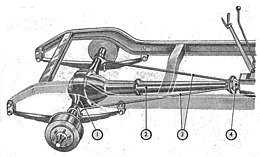
A torque tube system is a power transmission and braking technology that involves a stationary housing around the drive shaft, often used in automobiles with a front engine and rear drive. The torque tube consists of a large diameter stationary housing between the transmission and rear end that fully encloses a rotating tubular steel or small-diameter solid drive shaft (known colloquially in the U.S. as a "rope drive"[1]) that transmits the power of the engine to a regular or limited-slip differential.[2] The purpose of a torque tube is to hold the rear end in place during acceleration and braking. Otherwise, the axle housing would suffer axle wrap, which is when the front of the differential lifts excessively during acceleration and drops down during braking. Its use is not as widespread in modern automobiles[3] as is the Hotchkiss drive, which holds the rear end in place and prevents it from flipping up or down, during acceleration and braking by anchoring the axle housings to the leaf springs using spring perches.[4]
- ^ Martin, Murilee (20 September 2017). "Cut-Down Engine of the Week: Pontiac Trophy 4". autoweek.com. Retrieved 11 July 2024.
- ^ Mitchell Automechanics. Prentice Hall. 1991. p. 456. ISBN 9780135837825.
- ^ "Open Shaft Advantages". The Glasgow Herald. 23 July 1929.
- ^ Severson, Aaron (22 March 2009). "Hotchkiss Drive". ateupwithmotor.com. Retrieved 11 July 2024.